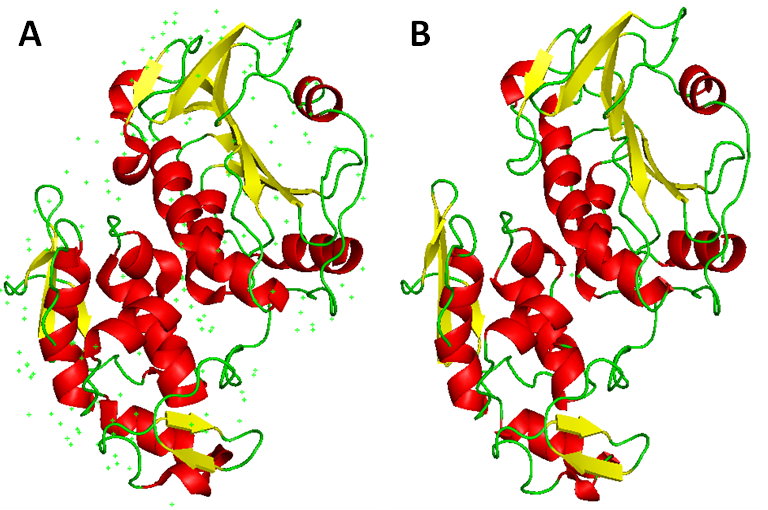Screening of Flavonoid Derivatives as Candidate Inhibitors For nsP2 Protease of Chikungunya Virus Using Molecular Docking
DOI:
https://doi.org/10.59535/faase.v2i1.179Keywords:
Flavonoids, nsP2 Protease, Chikungunya Virus, Molecular DockingAbstract
This study focuses on the potential inhibition of nsP2 protease of chikungunya virus by flavonoid-derived compounds. Non-structural proteins, particularly the nsP2 protease, have an important role in chikungunya virus replication. Flavonoid-derived compounds were chosen as candidate inhibitors because they have previously been shown to be effective against other viruses such as influenza, herpes, and dengue fever. This study used molecular docking method to test six flavonoid groups, and four of them, namely hesperidin, rhoifolin, myricetin, and genistin, showed promising binding affinity. The molecular visualization results showed the occurrence of hydrophobic interactions and hydrogen bond formation. Hesperidin, as a flavanone, stood out as the most potential candidate with a binding affinity value of -9.4 kcal/mol. This study has implications for the development of potential inhibitors to inhibit chikungunya virus replication.
Downloads
References
B. Dinda, M. Dinda, S. Dinda, and M. Chakraborty, ‘Some natural compounds and their analogues having potent anti- SARS-CoV-2 and anti-proteases activities as lead molecules in drug discovery for COVID-19’, European Journal of Medicinal Chemistry Reports, vol. 6, p. 100079, Dec. 2022, doi: 10.1016/j.ejmcr.2022.100079.
M. Islamuddin et al., ‘Inhibition of Chikungunya Virus Infection by 4-Hydroxy-1-Methyl-3-(3-morpholinopropanoyl)quinoline-2(1H)-one (QVIR) Targeting nsP2 and E2 Proteins’, ACS Omega, vol. 6, no. 14, pp. 9791–9803, Apr. 2021, doi: 10.1021/acsomega.1c00447.
D. Harisman et al., ‘The Effect of Drug Prices, Facilities on Customer Satisfaction through Service Quality’, Sao Paulo, 2021.
J. H. Zothantluanga et al., ‘Chapter 12 - Computational screening of phytochemicals for anti-parasitic drug discovery’, in Phytochemistry, Computational Tools and Databases in Drug Discovery, C. Egbuna, M. Rudrapal, and H. Tijjani, Eds., in Drug Discovery Update. , Elsevier, 2023, pp. 257–283. doi: 10.1016/B978-0-323-90593-0.00005-8.
R. Yadav et al., ‘Investigating into the molecular interactions of flavonoids targeting NS2B-NS3 protease from ZIKA virus through in-silico approaches’, Journal of Biomolecular Structure and Dynamics, vol. 39, no. 1, pp. 272–284, Jan. 2021, doi: 10.1080/07391102.2019.1709546.
R. Abdizadeh, F. Hadizadeh, and T. Abdizadeh, ‘Evaluation of apigenin-based biflavonoid derivatives as potential therapeutic agents against viral protease (3CLpro) of SARS-CoV-2 via molecular docking, molecular dynamics and quantum mechanics studies’, Journal of Biomolecular Structure and Dynamics, vol. 41, no. 13, pp. 5915–5945, Sep. 2023, doi: 10.1080/07391102.2022.2098821.
M. Wang, L. Wang, P. Leng, J. Guo, and H. Zhou, ‘Drugs targeting structural and nonstructural proteins of the chikungunya virus: A review’, International Journal of Biological Macromolecules, vol. 262, p. 129949, Mar. 2024, doi: 10.1016/j.ijbiomac.2024.129949.
T. P. Saliu, H. I. Umar, O. J. Ogunsile, M. O. Okpara, N. Yanaka, and O. O. Elekofehinti, ‘Molecular docking and pharmacokinetic studies of phytocompounds from Nigerian Medicinal Plants as promising inhibitory agents against SARS-CoV-2 methyltransferase (nsp16)’, Journal of Genetic Engineering and Biotechnology, vol. 19, no. 1, p. 172, Dec. 2021, doi: 10.1186/s43141-021-00273-5.
R. Hossain et al., ‘In Silico Screening of Natural Products as Potential Inhibitors of SARS-CoV-2 Using Molecular Docking Simulation’, Chin. J. Integr. Med., vol. 28, no. 3, pp. 249–256, Mar. 2022, doi: 10.1007/s11655-021-3504-5.
R. S. Joshi et al., ‘Discovery of potential multi-target-directed ligands by targeting host-specific SARS-CoV-2 structurally conserved main protease’, Journal of Biomolecular Structure and Dynamics, vol. 39, no. 9, pp. 3099–3114, Jun. 2021, doi: 10.1080/07391102.2020.1760137.
R. Dey, A. Samadder, and S. Nandi, ‘Exploring the Targets of Novel Corona Virus and Docking-based Screening of Potential Natural Inhibitors to Combat COVID-19’, Current Topics in Medicinal Chemistry, vol. 22, no. 29, pp. 2410–2434, Nov. 2022, doi: 10.2174/1568026623666221020163831.
A. Nivestam, A. Westergren, P. Petersson, and M. Haak, ‘Factors associated with good health among older persons who received a preventive home visit: a cross-sectional study’, BMC public health, vol. 20, pp. 1–7, 2020.
L. Ivanova, K. Rausalu, E. Žusinaite, J. Tammiku-Taul, A. Merits, and M. Karelson, ‘1,3-Thiazolbenzamide Derivatives as Chikungunya Virus nsP2 Protease Inhibitors’, ACS Omega, vol. 6, no. 8, pp. 5786–5794, Mar. 2021, doi: 10.1021/acsomega.0c06191.
M. A. Abdulghani, S. A. Alshehade, S. Kamran, and M. A. Alshawsh, ‘Effect of monosodium glutamate on serum sex hormones and uterine histology in female rats along with its molecular docking and in-silico toxicity’, Heliyon, vol. 8, no. 10, p. e10967, 2022.
D. Kumar, K. Kumari, A. Jayaraj, and P. Singh, ‘Development of a theoretical model for the inhibition of nsP3 of Chikungunya virus using pyranooxazoles’, Journal of Biomolecular Structure and Dynamics, vol. 38, no. 10, pp. 3018–3034, Jul. 2020, doi: 10.1080/07391102.2019.1650830.
N. Khan, R. Bhat, A. K. Patel, and P. Ray, ‘Discovery of small molecule inhibitors of chikungunya virus proteins (nsP2 and E1) using in silico approaches’, Journal of Biomolecular Structure and Dynamics, vol. 39, no. 4, pp. 1373–1385, Mar. 2021, doi: 10.1080/07391102.2020.1731602.
P. Forsyth, ‘Pre-financing airport investments, efficiency and distribution: Do airlines really lose?’, Journal of Air Transport Management, vol. 67, pp. 259–267, 2018.
S. Farisi and Q. R. Siregar, ‘Pengaruh Harga dan Promosi Terhadap Loyalitas Pelanggan Pengguna Jasa Transportasi Online di Kota Medan’, Maneggio: Jurnal Ilmiah Magister Manajemen, vol. 3, no. 1, pp. 148–159, 2020.
A. A. A. E. Elmenshawy, I. Alomar, A. Arshad, and A. Medvedevs, ‘Computational Fluid Dynamics Analysis of Flow Characteristics and Heat Transfer Variabilities in Multiple Turbine Blade Cooling Channels’, Transport and Telecommunication Journal, vol. 25, no. 1, pp. 77–96, Feb. 2024, Accessed: Mar. 12, 2024. [Online]. Available: https://sciendo.com/article/10.2478/ttj-2024-0008
B. A. Kusi, E. K. Agbloyor, A. Gyeke-Dako, and S. A. Asongu, ‘Financial Sector transparency and net interest margins: Should the private or public Sector lead financial Sector transparency?’, Research in International Business and Finance, vol. 54, p. 101260, Dec. 2020, doi: 10.1016/j.ribaf.2020.101260.
R. S. Joshi et al., ‘Discovery of potential multi-target-directed ligands by targeting host-specific SARS-CoV-2 structurally conserved main protease’, Journal of Biomolecular Structure and Dynamics, vol. 39, no. 9, pp. 3099–3114, Jun. 2021, doi: 10.1080/07391102.2020.1760137.
J. H. Castro e Silva, J. T. Souza, C. Schitine, A. de F. S. Júnior, E. M. S. Bastos, and S. L. Costa, ‘Pharmacological Potential of Flavonoids against Neurotropic Viruses’, Pharmaceuticals, vol. 15, no. 9, Art. no. 9, Sep. 2022, doi: 10.3390/ph15091149.
A. Pramana et al., ‘Counseling and Socialization About Making Cow Candy as Supplementary Feed for Ruminants’, Journal of Community Engagement Research for Sustainability, vol. 2, no. 5, pp. 210–216, 2021.
M. Aboubakr et al., ‘Antioxidant and anti-inflammatory potential of thymoquinone and lycopene mitigate the chlorpyrifos-induced toxic neuropathy’, Pharmaceuticals, vol. 14, no. 9, p. 940, 2021.
L. F. Christensen, B. García-Béjar, C. H. Bang-Berthelsen, and E. B. Hansen, ‘Extracellular microbial proteases with specificity for plant proteins in food fermentation’, International Journal of Food Microbiology, p. 109889, 2022.
H. Tijjani, A. P. Adegunloye, A. Uba, J. O. Adebayo, G. A. Gyebi, and I. M. Ibrahim, ‘Pharmacoinformatic study of inhibitory potentials of selected flavonoids against papain-like protease and 3-chymotrypsin-like protease of SARS-CoV-2’, Clin Phytosci, vol. 8, no. 1, p. 16, Sep. 2022, doi: 10.1186/s40816-022-00347-y.
A. T. Jamiu, C. H. Pohl, S. Bello, T. Adedoja, and S. Sabiu, ‘A review on molecular docking analysis of phytocompounds against SARS-CoV-2 druggable targets’, All Life, vol. 14, no. 1, pp. 1100–1128, Jan. 2021, doi: 10.1080/26895293.2021.2013327.
K. Kovacikova and M. J. van Hemert, ‘Small-Molecule Inhibitors of Chikungunya Virus: Mechanisms of Action and Antiviral Drug Resistance’, Antimicrobial Agents and Chemotherapy, vol. 64, no. 12, p. 10.1128/aac.01788-20, Nov. 2020, doi: 10.1128/aac.01788-20.
B. A. Ismail, Z. H. Abd El-Wahab, O. A. M. Ali, and D. A. Nassar, ‘Synthesis, structural characterization, and antimicrobial evaluation of new mononuclear mixed ligand complexes based on furfural-type imine ligand, and 2,2′-bipyridine’, Sci Rep, vol. 13, no. 1, Art. no. 1, Jun. 2023, doi: 10.1038/s41598-023-36060-0.
S. Rana, S. Sharma, and K. S. Ghosh, ‘Virtual Screening of Naturally Occurring Antiviral Molecules for SARS-CoV-2 Mitigation Using Docking Tool on Multiple Molecular Targets’. ChemRxiv, Jun. 02, 2020. doi: 10.26434/chemrxiv.12403940.v1.
L. R. Silva et al., ‘Targeting Chikungunya Virus Entry: Alternatives for New Inhibitors in Drug Discovery’, Current Medicinal Chemistry, vol. 29, no. 4, pp. 612–634, Feb. 2022, doi: 10.2174/0929867328666210623165005.
B. Silva Andrade et al., ‘Computational screening for potential drug candidates against the SARS-CoV-2 main protease’, F1000Res, vol. 9, p. ISCB Comm J-514, Dec. 2020, doi: 10.12688/f1000research.23829.2.

Downloads
Published
How to Cite
Issue
Section
License
Copyright (c) 2024 Khoirul, Rong Cao, Antonio Zucca

This work is licensed under a Creative Commons Attribution 4.0 International License.
By submitting a manuscript to Frontier Advances in Applied Science and Engineering (FAASE), the author(s) agree to the following terms:
-
Copyright: The author(s) retain copyright to their work, granting Frontier Advances in Applied Science and Engineering (FAASE) the right to publish it. Articles are licensed under a Creative Commons Attribution 4.0 International License (CC BY).
-
License Grant: The CC BY license allows others to share and adapt the work for any purpose, even commercially, provided proper attribution is given to the original author(s) and the source, a link to the Creative Commons license is provided, and any changes made are indicated.
-
Author's Rights: Authors are allowed to enter into separate, additional contractual arrangements for the non-exclusive distribution of the journal's published version of the work, with proper acknowledgment of its initial publication in Frontier Advances in Applied Science and Engineering (FAASE).
-
Permissions: Reproduction, posting, transmission, or other distribution or use of the final published article, in whole or in part, requires prior written permission from Frontier Advances in Applied Science and Engineering (FAASE) and the respective author(s).
-
Attribution: Proper attribution must be given to the original author(s) and the source, indicating that the work was originally published in Frontier Advances in Applied Science and Engineering (FAASE) with a link to the published article.
-
No Warranty: The journal and its editorial team make no representations or warranties regarding the accuracy, completeness, or fitness for a particular purpose of the published work.
-
Dispute Resolution: Any disputes arising from the use of the licensed material shall be governed by the laws of [Jurisdiction] without regard to conflicts of law principles.
By submitting a manuscript to FAASE, the author(s) agree to abide by these license terms and grant the necessary rights to Frontier Advances in Applied Science and Engineering (FAASE) for the publication and dissemination of the submitted work.
Most read articles by the same author(s)
- Khoirul Faqih, Rong Cao, Saeed Ahmad, Muntholib Muntholib, Synthesis and Characterization of Complex Compounds of Cadmium (II) Nitrate, Potassium Thiocyanate, and 2,2-Bipyridine Ligand , Frontier Advances in Applied Science and Engineering: Vol. 1 No. 2 (2023)










